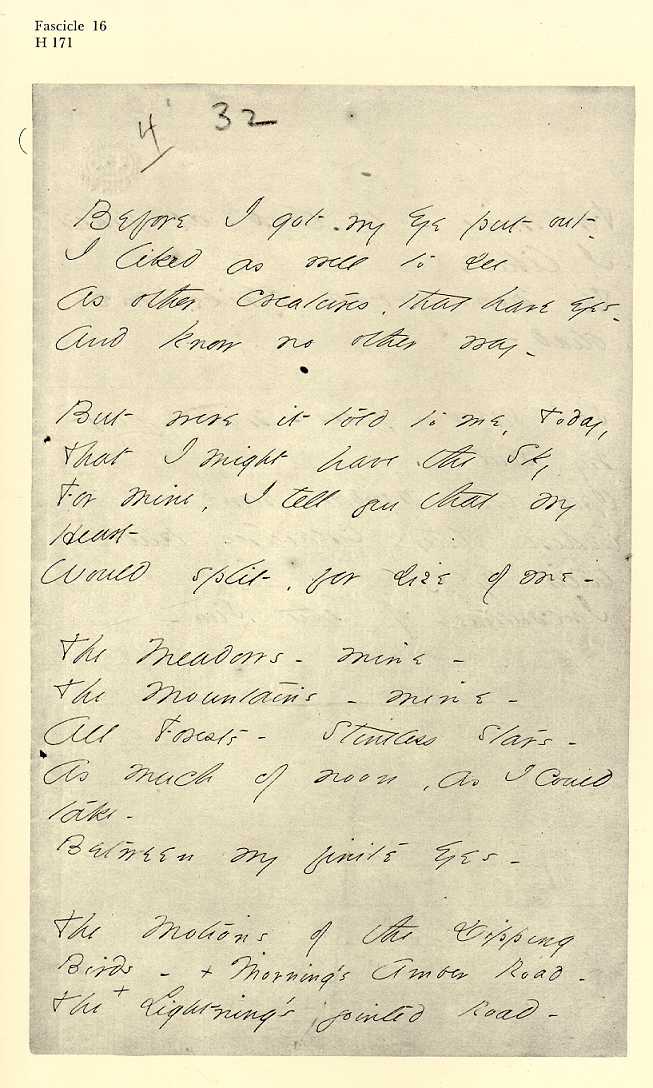A piece of writing that I think is important is Emily Dickinson’s “fascicles,” a term used by her editor Mabel Loomis Todd to describe her 40, hand-sewn booklets of poetry. If I were to encode the 800+ poems that comprise the “fascicles,” I would begin by marking up the stanzas and lines, as well as the marginalia.
What I would add to the documents, however, are XML IDs to ensure that the poems are read in the order that they were written – which is not the case today. If the stanzas, lines, marginalia, and order of the poems are not well preserved or are missing from the markup, then several issues could arise – a false representation of Dickinson’s work and a mystification of her intent chief among them.
Conflicts of interest not witstanding, an XML file of one of Dickinson’s poems would probably include several <p> tags for each line, as well as several @xml:id and @n attributes to express a reference system, which, in the case of Dickinson’s “fascicles,” could refer to the specific booklet that each respective poem was found in. The result would be reminiscent of something that could be found in the University of Virginia Dickinson Electronic Archives:
<?xml version=”1.0″ encoding=”UTF-8″?> <text> <body> <div0 type=”verse”> <pb n=”1″ entity=”a257a” /> <lg n=”1″> <l n=”1″>It sifts from Leaden</l> <l n=”2″>sieves</l> <l n=”3″>It powders all the Wood</l> <l n=”4″>It fills with Alabaster</l> <l n=”5″>Wool</l> <l n=”6″>The Wrinkles of the</l> <l n=”7″>Road -</l> <l n=”8″>It scatters like</l> <l n=”9″>the Birds</l> <l n=”10″>Condenses like a Flock</l> <l n=”11″>Like – Juggler’s Flowers</l> <l n=”12″>situates</l> <l n=”13″>Upon a Baseless Arc -</l> <l n=”14″>It traverses – yet halts -</l> <l n=”15″>Disperses, while it stays</l> <l n=”16″>Then curls itself in</l> <pb n=”2″ entity=”a257b” /> <l n=”17″>Capricorn</l> <l n=”18″>Denying that it was -</l> </lg> </div0> </body> </text>
Fascicle 24: Poem 155a “It sifts from Leaden Sieves.”
Most of Dickinson’s oeuvre has already been encoded in XML vis-à-vis the main Emily Dickson Archive. The two main repositories are hosted by Amherst College and Harvard, though the Emily Dickinson Archive as a whole remains a joint effort between Boston Public Library, University of Maryland, University of Nebraska, and Brigham Young University.

Fascicle 16: Poem 1 “He showed me hights I never saw.”
What I find most interesting about XML is that it gives the user the ability to preserve texts, while still giving them the autonomy to define their own variables. I thus see XML as a more resilient language than HTML since the user dictates the language rather than the language dictating the user – which, in my opinion, contributes to XML’s longevity, while still leaving room for it to grow. I am interested in seeing the development of the language as new elements are defined and repurposed alongside singular projects.
PHOTOS LICENSED UNDER CREATIVE COMMONS LICENSE
